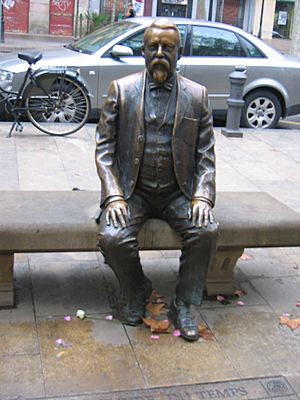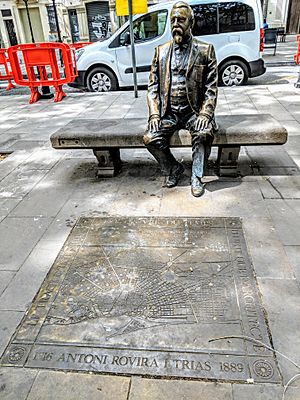Antoni Rovira i Trias facts for kids

Antoni Rovira i Trias (born 1816 in Barcelona – died 1889 in Barcelona) was a very important Catalan architect and urban planner. An urban planner is someone who designs how cities should be built and organized. Rovira i Trias helped create many buildings in Barcelona and had big ideas for how the city should grow. He also started several groups, including the Societat Filomàtica de Barcelona.
Buildings Designed by Rovira i Trias
Antoni Rovira i Trias is known for designing several important buildings in Barcelona. Many of these are famous markets that are still used today.
- Barceloneta Market (1873)
- La Concepció Market (1885) on Carrer d'Aragó
- El Born Market (1876)
- Sant Antoni Market (1879)
He also designed other notable structures. These include the Passatge del Comerç (1855), a special walkway, and the Teatre Circ Barcelonès (1853), a theater. He also worked on the loggia (an open-sided gallery) of Palau Moja (1856). A very important project for the city was helping to tear down the Ciutadella. This was an old military fortress from the 1700s. Removing it made space for new city developments.
His Vision for Barcelona
Rovira i Trias had a special plan for how Barcelona should expand. His plan was called Le tracé d’une ville est oeuvre du temps plutôt que d’architecte. This means "The layout of a city is the work of time rather than an architect." His idea was for a city that grew outwards from a center, like spokes on a wheel. This is called a radial plan.
His plan competed with another famous urban planner, Ildefons Cerdà. In 1859, Rovira i Trias's plan actually won a contest held by the city council. However, the central Spanish government in Madrid chose Cerdà's plan instead. Construction on Cerdà's plan started the next year.
Over time, Cerdà's plan was not fully completed as he had imagined. For a long time, Rovira's plan and his contributions were largely forgotten. But recently, a book was published that brought his work back into the spotlight. This book highlighted Rovira's fair and equal approach to city planning. It also showed how many small but important details in Barcelona were thanks to his ideas.
See also
 In Spanish: Antonio Rovira y Trías para niños
In Spanish: Antonio Rovira y Trías para niños
- Eixample
- Urban planning of Barcelona


